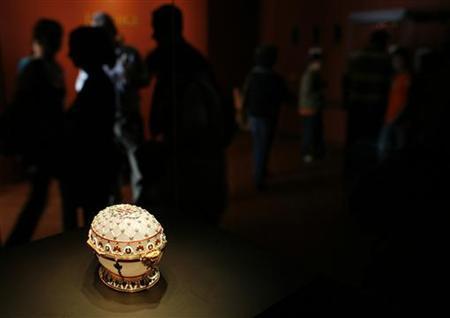
The Renaissance Faberge egg is displayed during the exhibition "Treasures of Imperial Russia" in Croatia's Adriatic town of Dubrovnik on November 3, 2007.
Revived luxury firm Faberge, whose namesake designed jewel-encrusted eggs for Russian Tsars, plans to sell its first collection of jewelry pieces worth up to $7 million each to the ultra rich on the Web.
The privately-held group is aiming to break into the competitive luxury goods market with limited investment during a downturn and eventually challenge giants like Bulgari, Tiffany and Cartier.
"We decided to be bold. We saw this as a massive opportunity," Chief Executive Mark Dunhill said at a launch on Wednesday.
Faberge seeks to lure the wealthy through its website showcasing jewelry encrusted with thousands of gems, then consummate sales with private showings.
It will save millions of dollars of investment by eschewing the traditional mode of selling at strings of luxury boutiques and initially will have only one shop in Geneva.
"You're taking a very big risk if you are building a network of stores," said Dunhill, former president of Alfred Dunhill, the leather and accessories brand of Swiss luxury goods maker Richemont.
"We are embarking on a pioneering business model."
Faberge wants to break into a sector that is seeing a deep slump overall, but where top names are still spending huge amounts to attract the rich.
"The barriers to entry are much higher now," Dunhill said, adding that Louis Vuitton was spending $25 million on a new shop in London.
LURE RICH WITH INTERNET
Faberge is hoping the wealthy who want an exclusive experience will embrace its website as a starting point, before personally being shown a brooch or ring. Dunhill said a survey of millionaires showed 95 percent made their last purchase on the Web.
"If you are thinking of spending $1 million for a bracelet, why not have the designer come out to you and show it to you on your yacht?" Dunhill said.
French boutique jeweler Frederic Zaavy is Faberge's designer and has created an initial collection of 100 items at his studio in Paris.
Zaavy, who had his own workshop and sold privately for 14 years, uses hundreds or thousands of tiny gems on each piece to create mosaic effects on rings, brooches, earrings and necklaces.
The first collection ranges from $40,000 to $7 million, but some future items may sell for $15,000 and later other luxury products could be added.
It may take several years to become profitable as the group carves out a niche in the sector, Dunhill said in an interview.
"This is a very elite business seeking to attract a devoted base of connoisseurs... realistically a business like this takes time to grow," he said.
"We are targeting a break-even within a reasonable time frame." When asked if five years was reasonable, he replied: "Yes, I think we'd be happy and our shareholders would be happy if we achieved that."
Dunhill declined to say how much had been invested so far, but said the group had no debt.
Mining investment group Pallinghurst Resources, which owns about half of the group, bought the Faberge brand from Unilever in 2007 and launched a revival of the name which had been used to market mainstream cosmetics like Brut men's fragrance.
U.S. private equity group Midstream & Resources has a 20 percent stake and South African bank Investec owns around 10 percent.
The original Faberge company was founded in 1842 by Russian jeweler Gustav Faberge, who gained fame for designing elaborate jewel-encrusted eggs for Russia's Tsars.
At some point Faberge is likely to create the first egg since the Faberge family was scattered by the Russian revolution, Dunhill said.
Gustav's grandsons, who established a new Faberge firm in Paris, discovered after World War Two that a U.S. businessman was selling perfume under their family name.
They launched a lawsuit, but ran out of money and ceded rights to their family name to a U.S. firm in 1951 for $25,000. The Faberge brand then went through many owners before being sold for $1.55 billion to consumer goods group Unilever in 1989.





